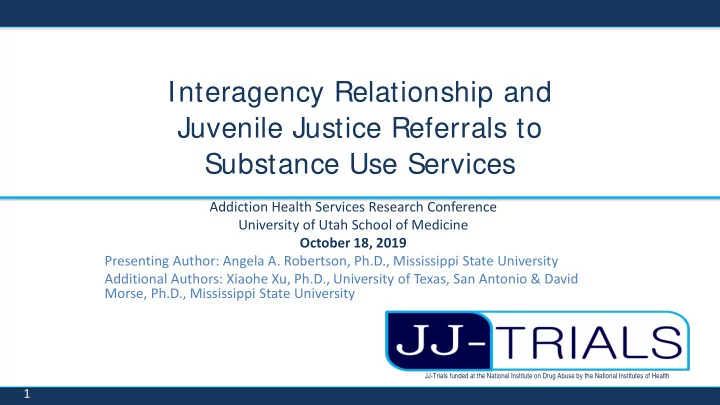

Interagency Relationship and Juvenile Justice Referrals to Substance Use Services Addiction Health Services Research Conference University of Utah School of Medicine October 18, 2019 Presenting Author: Angela A. Robertson, Ph.D., Mississippi State University Additional Authors: Xiaohe Xu, Ph.D., University of Texas, San Antonio & David Morse, Ph.D., Mississippi State University JJ-Trials funded at the National Institute on Drug Abuse by the National Institutes of Health 1
Acknowledgement This study was funded under the JJ-TRIALS cooperative agreement, funded at the National Institute on Drug Abuse (NIDA) by the National Institutes of Health (NIH) . The authors gratefully acknowledge the collaborative contributions of NIDA and support from the following grant awards: Chestnut Health Systems (U01DA03622) Columbia University (U01DA036226 ) Emory University (U01DA036233) Mississippi State University (U01DA036176) Temple University (U01DA036225) Texas Christian University (U01DA036224) University of Kentucky (U01DA036158) The contents of this publication are solely the responsibility of the authors and do not necessarily represent the official views of the NIDA, NIH, or the participating universities or juvenile justice systems. 2
Background • Substance use (SU) and SU disorders are highly prevalent among youth under juvenile justice (JJ) community supervision. • Yet, only a fraction of justice-involved youth in need of SU treatment services receive such services. • The capacity of the JJ system to address the treatment needs of juveniles with SUDs remains problematic due to challenges related to – identifying the underlying problems, – referring youth to appropriate services provided by other agencies, – and coordinating with service providers to ensure that youth actually receive services. 3
Background • Research on collaboration between child welfare and children mental health suggests that inter-agency collaboration can help agencies ensure that youth receive necessary services. • This study focuses on interagency relationships between 34 Juvenile Justice (JJ) agencies and local SU treatment providers participating in the Juvenile Justice – Translational Research on Interventions for Adolescents in the Legal System (JJTRIALS) cooperative research initiative. • Administrative and line staff from participating agencies were asked to form interagency change teams and work together to reduce unmet SU-related needs of justice-involved youth. 4
Background • We examined variables from the Resource Dependence Theory (Van de Ven & Walker, 1984) to understand how inter-organizational collaboration may influence client referrals from JJ agencies to treatment providers over time. • Public sector or social services agencies are more likely to form collaborative relationships when resources are scarce, when there is similarity between the agencies (e.g., services, clients), and when the two agencies’ objectives can be achieved through cooperation. • Factors shown to facilitate and inhibit interagency collaboration include – Trust & mutual respect across agencies – Shared understanding & joint training – Communication – Confidentiality issues 5
M1 M25 Post-Experiment Research Period : Baseline Experiment EPIS Stage : Exploration Preparation Implementation Sustainment Strategies : Strategies : Strategies : Strategies Applied • Interagency BH Training • Workgroup meetings In Core & Enhanced Sites : Goal WG • Application of DDDM/Tools established Achievement • Facilitation (Enhanced Sites • Needs /DDDM only) Assessment Training & • Site Tools Feedback Report Staff Survey Staff Survey Staff Survey Staff Survey Data Collection : T1, M5 T2, M9 T3, M19 T4, M25 WG = workgroup; DDDM = Data-driven Decision Making; M = month 6
Methods: Measures of Inter-organizational Relationships Resource Dependence • 2 items, Alphas ranging from .794 to .827 Relationship Effectiveness • 8 items, Alphas ranging from .915 to .932 Frequency of SU-related Information Sharing • 4 items, Alphas ranging from .826 to .874 Frequency of Inter-agency Communications • 4 items, Alphas ranging from .846 to .871 Frequency of Client Referrals : To what extent does your agency send youth with alcohol or drug problems to the local treatment provider? 7
Results: Path Model (n= 192) Time 1 Time 2 Time 3 Resource Dependence Resource Dependence Resource Dependence .28*** .50*** .47*** Relationship Relationship Relationship Effectiveness Effectiveness Effectiveness .11 + .30*** .56*** .44*** .38*** Communication Communication Communication Frequency Frequency Frequency .11* Information Sharing Information Sharing Information Sharing .51*** .63*** .47*** Client Referrals Client Referrals Client Referrals .21*** .38*** 8 +p< .10, *p<.05, **p<.01, ***p<.001
Conclusion • Resource dependence does account for differences in referrals, but indirectly. • Information sharing both directly and indirectly influences referrals. • Effectiveness directly influences Information sharing, and indirectly influences referrals within and across times. • The IVs accounted for 26% (at Baseline), 44% (at Time 2) and 40% (at Time 3) of variance in referrals. • Hence, prior levels of Resource dependence, Effectiveness, and Information sharing contribute to enhanced levels of explanation for subsequent numbers of referrals. 9
Conclusion • The linkage of justice-involved youth with SU problems to treatment services is both initiated and maintained when specific kinds of information is shared between JJ and service provider agencies. • More frequent information sharing and client referrals are associated with interagency relationships characterized by – JJ staff being well informed about provider services and being personally acquainted with provider staff – Willingness to invest time and effort into relationship building – Trust that each agency would honor commitments and agreements 10
Questions? Angela Robertson angela.robertson@ssrc.misstate.edu 11
Recommend
More recommend